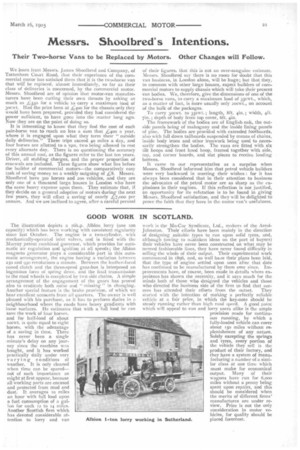Messrs. Shoolbrect s Intentions.
Page 21

If you've noticed an error in this article please click here to report it so we can fix it.
Their Two-horse Vans to be Replaced by Motors. Other Changes will Follow.
We learn from Messrs. James Simolbred and Company, of Tottenham Court Road, that their experience of the commercial motor has satisfied them that it is the two-horse van that willbe replaced, almost immediately, so far as their class of deliveries is concerned, by the commercial motor. Messrs. Shoolbred are of opinion that motor-van manufacturers have been cutting their own throats by asking as much as .L.550 for a vehicle to carry a maximum load of 3ocwt. Had the price been at E,400 for the chassis only they would have been prepared, provided they had considered the
c:iever sufficient, to have gone into the matter long ago. Now they are on the point of doing so. It is interesting to know that they find the cost of each pair-horse van to reach no less a sum that £400 a year, where it is engaged upon what they term their "outside daily deliveries." These trips exceed 442 miles a day, and four horses are allotted to a van, two being allowed to rest every alternate day. There is no questioning the accuracy of this annual cost, as the figures refer to the last ten years. Driver, all stabling charges, and the proper proportion of renewals are included. These figures show what lies before the builder of commercial motors—the comparatively easy task of saving money on a weekly outgoing of LS. Messrs. Shoolbreci have 300 horses and zoo vehicles, and they are only one of a thousand large houses in London who have the same heavy expense upon them. They estimate that, if they decide on a general adoption of motors.during the next few years, they will effect a saving of nearly £7,000 per annum. And we are inclined to agree, after a careful perusal of their figures, that this is not an over-sanguine estimate. Messrs. Shoolbred say there is no room for doubt that this van business, in London alone, will be huge; but that they, in common with other large houses, expect builders of commercial motors to supply chassis which will take their present van bodies. We, therefore, give the dimensions of one of the two-horse vans, to carry a maximum load of 35cwt., which, as a matter of fact, is more usually only zocwt., on account of the bulk of the packages. To carry 3ocwt. to 35cwt.; length, 81t. 4in.; width, 4ft. 7in. ; depth of body from top cover, 6ft. kin.
The framework of the bodies are of English oak, the outside panels being of Mahogany and the inside lining panels of pine. The bodies are provided with extended footboards, also with fall down tailboards suspended by means of chains, inside body irons and other ironwork being used to necessarily strengthen the bodies. The vans are fitted with six tilt hoops and front hood hoop, framed together with side, top, and corner boards, and slat pieces to receive loading battens.
It came to our representative as a surprise when Messrs. Shoolbrcd informed him that petrol vehicle builders were very backward in meeting their wishes : for it has always been considered that in their attention to business the advocates of the petrol motor are as sharp as the explosions in their engines. If this reflection is not justified, an opportunity for its refutation is to be found in giving Messrs. Shcxx.Ihred satisfaction, and they will be delighted-to prove the faith that they have in the motor van's usefulness.
























